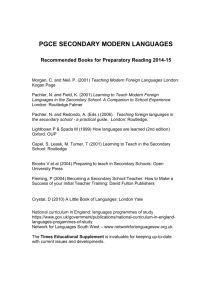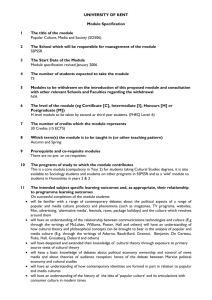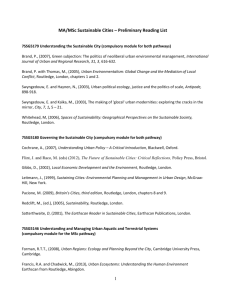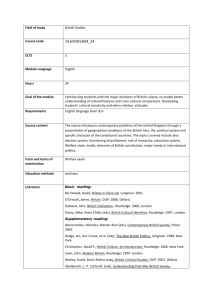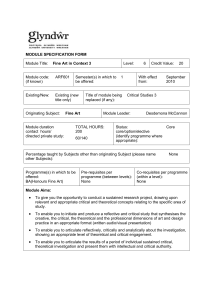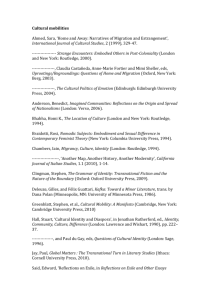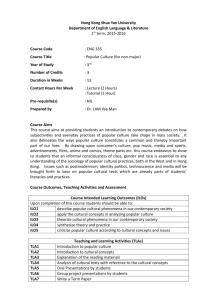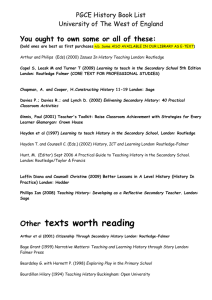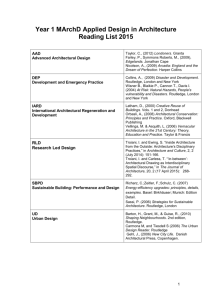Consuming Signs - Robert Gordon University
advertisement
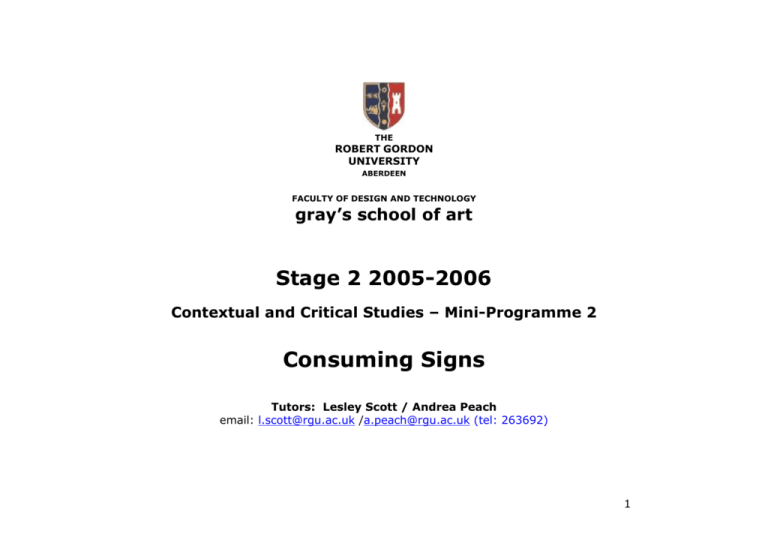
THE ROBERT GORDON UNIVERSITY ABERDEEN FACULTY OF DESIGN AND TECHNOLOGY gray’s school of art Stage 2 2005-2006 Contextual and Critical Studies – Mini-Programme 2 Consuming Signs Tutors: Lesley Scott / Andrea Peach email: l.scott@rgu.ac.uk /a.peach@rgu.ac.uk (tel: 263692) 1 CONSUMING SIGNS This programme will look at how we ‘consume’ culture, and the ways in which the art and design ‘industries’ increasingly produce commodities that we consciously or unconsciously desire and aspire to possess. We will investigate theories behind the complex system of cultural signs and signifiers that surround us all, and use case studies from consumer culture, as a means of critiquing art and design practice. Cultural artefacts can be read on many different levels; both design and art are subject to commodification, and may circulate meaning. By the end of this programme, you should have a better understanding of what is meant by cultural consumption, the commodification of art and design, and the application of semiotics to advertising and branding. 1. INTRODUCTION AND TIMETABLE This programme comprises one of two mini-programmes running in Semester Two 2006/07. Each programme runs across 3 weeks, and includes a lecture on Mondays at 1.00 pm, SB42 Scott Sutherland School, followed by seminars for Stage 2 on Tuesdays in A34M Gray’s School of Art. Seminar groups and times will be posted on the CCS noticeboard (by the art school shop). Students must come to the seminars prepared to participate. 2 Weekly seminar details can be found in the course outline which follows. Assessment will be based on seminar 2. 12 Feb 5 6 7 8 9 19 Feb 26 Feb 5 Mar 12 Mar 19 Mar 26 Mar Programme 1 Judith Findlay ‘A Delicate Shuttle: Art as Non Modern’ Programme 2 Andrea Peach / Lesley Scott ‘Consuming Signs’ 10 11 12 13 14 15 10 Apr 16 Apr 23 Apr 30 Apri 7 May 14 May Assessment 2&3 5 Feb 4 Assessment 2&3 29 Jan 3 Hand in CCS Coursework 2 April Break Stage 2 23 Jan Post Assessment Break SEMESTER 2 2006 1 BRIEFING MONDAY 5 Feb SB42 12-1 WK 2 April participation and a written assignment. Details of the assignment are given below. OVERALL OBJECTIVES OF THE CONTEXTUAL AND CRITICAL STUDIES MINI-PROGRAMMES The Contextual and Critical Studies mini-programmes aim to encourage discussion of contemporary practice and theory with a view to situating that discussion in a wider cultural and historical framework, and enabling you to make links with studio practice. At the end of this series of mini-programmes you will be expected to: 3 Demonstrate an increased understanding of both the historical and contemporary context relating to art and design theory and practice. Further develop the ability to analyse, read and critique your own studio work in relation to a wider range of themes and a broader cultural context. Demonstrate an ability to undertake research relevant to the critical aims of the programme, using both paper based and electronic sources. Build up confidence in discussing and sustaining a critical argument that is clear and consistent. Begin to consider self- directed areas of research in Contextual and Critical studies relating to your studio practice and emerging critical interests. 3. COURSEWORK Seminar Participation and Attendance There are three seminars for each mini-programme in Stage 2. The seminars will follow the theme of the lectures and will address a particular issue each week. Students will be placed in groups and are expected to contribute to the seminars as part of their assessment. For this reason, it is essential that students attend all lectures and seminars relating to their elected mini-programme. If for any reason, you are unable to attend, please email your 4 tutor. Details of the seminar tasks and groups will be found in the weekly schedule that follows and will be discussed in the first seminar. Assessment This semester you are asked to complete one piece of assessment. There are two components to the assessment comprising a Critical Notebook and an Essay. Critical Notebook Apply personal reflection and academic research to compile a Critical Notebook inspired by the mini-programme theme. Where possible relate the content to your own studio activity and interests. The Critical Notebook should take the form of a hard-backed notebook, no larger than A3, and can comprise writing, drawings, photographs, sketches and any other materials relevant to the analysis and criticism of your chosen mini-programme. It should contain your responses and thoughts in relation to the lectures and seminars, as well as any additional research and development you have undertaken in relation to these. Your Essay should be securely incorporated within your Notebook. 5 Essay For the essay, you are asked to critically evaluate an aspect of how we consume signs. To do this, you should focus on one of the three lecture themes, and use your own examples to illustrate your understanding of how we consume signs. Make links, where appropriate, between your own studio interests and subject. Your essay should comprise approximately 1,500-2,000 words, must be fully word-processed and include a comprehensive bibliography. You will be expected to reference all sources used in your text, using the Vancouver referencing system (see section 5: ‘Referencing Sources’ for details). The submission date for the Critical Notebook and Essay for this mini-programme is: Tuesday April 10th 2007 4. REFERENCING SOURCES RGU has adopted two systems for referencing sources: Harvard (also known as Author/Date) and Vancouver (also known as ‘endnotes’ or ‘footnotes’). For your written assignment, we recommend that you use Vancouver and Footnotes. You will find information on Vancouver in handouts available from the CCS website, at www.studioit.org.uk See Contextual and Critical Studies / Support Files 2006/7 / General CCS Documents: 6 Vancouver Referencing System – Sheet of examples Guide to Academic Referencing Please note that failure to fully reference quotations and sources constitutes plagiarism which is a serious academic offence with corresponding penalties. 6. Consult your tutor if you have any queries about referencing. EXTENSION REQUESTS Extensions will only be granted in exceptional circumstances, which encompass serious and acute problems or events which genuinely affect your ability to complete coursework on time. Such circumstances could include: serious physical or mental illness (must have doctor's certificate), serious illness or death of an immediate family member or close friend. 'Exceptional circumstances' do not include colds, headaches, hangovers, poor time management, problems caused by English not being your first language, and circumstances within your control (absence due to holidays, weddings, jobs etc). To request an extension, please complete a Coursework Extension Request Form (available from the School Office). This form must be submitted before the coursework submission date, and include written documentation (medical certificates etc.) where relevant. Claims are reviewed by your CCS tutor and treated as confidential. Coursework handed in after the hand-in date, which is not supported by a fully approved Coursework Extension Request Form will be recorded as a non-submission. There will be no exceptions. 7 8 Week 7 Semester 2 Monday 12th March 1.00 SB42 Scott Sutherland School LECTURE 1: Consumption as Manipulation? Key Issues and Questions How do we make meaning through consumption? Are we ‘active’ or ‘passive’ consumers? Do the processes of consumption manipulate or empower the individual? Key Writers Theodor Adorno (1903-1969) Jean Baudrillard (1929-) Angela McRobbie Mike Featherstone Case Study Girl’s magazines (Sugar, Bliss, More etc.) Required Reading Additional Reading Seminar Assignment Barnard, Malcolm, Art Design and Visual Culture, New York: St Martin’s Press, 1998, pp 185-196 McRobbie, Angela, Postmodernism and Popular Culture, London: Routledge, 1994, pp. 163-167 Storey, John, ‘Cultural Consumption as Manipulation’ in Cultural Consumption and Everyday Life, London: Arnold, 1999, pp. 18-35 Featherstone, Mike, ‘Lifestyle and Consumer Culture’ in Consumer Culture and Postmodernism, London: Sage, 1991, pp. 83-94 McRobbie, Angela, ‘MORE! New Sexualities in girl’s and women’s magazines’ in, In the Culture Society: Art, Fashion and Popular Music, London: Routledge, 1999, pp. 46-61 McRobbie, Angela, ‘Pecs and Penises – The Meaning of Girlie Culture’ in, In the Culture Society, pp. 122-131 Can you find examples of Adorno and Baudrillard’s theories on active and passive consumption in magazines aimed at youth culture? What precisely are these magazines selling? Are they simply providing choice or do they contain other subliminal messages? Please bring examples to the seminar. 9 10 Week 8 Semester 2 Monday 19th March 1.00 SB42 Scott Sutherland School LECTURE 2: Art, commodification and the ‘culture industry’? Key Issues and Questions Art within a capitalist economy; ideologically opposed or inextricably linked? Is Fine Art now more commodity than critique? Was ‘Young British Art’ more ‘culture industry’ Key Writers and Texts Julian Stallabrass – High Art Lite and Art Incorporated: The Story of Contemporary Art Pierre Bourdieu – Distinction. A Social Critique of the Judgement of Taste (primarily the Introduction and sections specifically addressing art) Key Works and Practitioners Pop Art, Young British Artists (See ‘Art Incorporated’ for more) Required Reading Stallabrass, J. ‘Uses and Prices of Art’ in Art Incorporated, Oxford, Oxford University Press, 2004, pp127-49 McRobbie, Angela, ‘Sensation: Art as Cultural Populism?’ in In the Culture Society. Art Fashion and Popular Music, London: Routledge, 1999, pp6-10 Suggested Reading Ford, Simon, ‘The Myth of the Young British Artist’ in Occupational Hazard. Critical Writing on Recent British Art, London: Black Dog Publishing, 1998, pp130-140 Keat, Russell, Whiteley, Nigel and Abercrombie, Nicholas, (eds), ‘High art and the high street: the ‘commerce-and-culture’ debate, in The Authority of the Consumer, London: Routledge, 1994, pp119-137 Stallabrass, J. ‘Consuming Culture’ in Art Incorporated, London: Stallabrass, J, ‘Saatchi and Sensation’ in High Art Lite, London: Verso, 1999, pp196-222 (See also Chapters 4 and 5) SeminarAssignment Did Young British Art critique consumer culture or was it complicit with and compromised by it? Does the ‘culture industry’ now influence the direction of art or can art maintain its separation? What precise challenges does a capitalist, corporate and consumer culture pose for Fine Art? Consider these questions in the light of the readings and come prepared to discuss. 11 12 Week 9 Semester 2 Monday 26th March 1.00 SB42 Scott Sutherland School Required Reading Suggested Reading Choose ONE Seminar Assignment LECTURE 3: Design as Commodity Key Issues and Questions Signs and myths and commodities: reviewing semiotics and consumption Decoding Advertisements: How are verbal and visual signs used to generate messages about products and their users? “Buy the Brand” – How are brands used to construct identity and sell products? Key Writers Roland Barthes – Mythologies Judith Williamson – Decoding Advertisements Jonathan Bignell – Media Semiotics Case Studies Examples will be taken from contemporary advertising and branding Bignell, Jonathan, ‘Advertisements’ in Media Semiotics: An Introduction, Manchester: Manchester University Press, 1997, pp. 30-36 Williamson, Judith, ‘Meaning and Ideology’ and ‘Sign, Signifier, Sign’ in Decoding Advertisements: Ideology and Meaning in Advertising, London: Marion Boyars, 2002, pp.11-14 and 17-19 Pavitt, Jane, ‘In Goods We Trust’, in Brand.New, London: V&A Publications, 2000, pp. 18-68 Goldman, Robert and Papson, Stephen, ‘Introduction: Advertising in the Age of Accelerated Meaning’ in Sign Wars: The Cluttered Landscape of Advertising, London: The Guildford Press, 1996, pp.1-19 Miles, Steven, ‘Design for Life or Consumption Designed?’, Consumerism as a Way of Life, London: Sage, 1998, pp.36-51 Paterson, Mark, ‘Logo or No-Logo? The Poetics and Politics of Branding’, Consumption and Everyday Life, London: Routledge, 2006, pp.197-223. Analyse the connotations of the brand names and logos of three products. Why were these names and logos chosen? Could any of them be used as the name of a product of a different type? Choose three ads for a similar type of product (car, training shoe, pension, perfume, etc.) How similar and how different are the mythical meanings of the products in the three ads? Why is this? What semiotic connotations are contained within 13these ads? 7. BIBLIOGRAPHY AND ADDITIONAL SOURCES GENERAL TEXTS Adorno, Theodor, The Culture Industry: Selected Essays on Mass Culture, London: Routledge, 2001 Barnard, Malcolm, Art Design and Visual Culture, New York: St Martin’s Press, 1998 Barnard, Malcolm, Fashion as Communication, London: Routledge, 1996 Baudrillard, Jean, Selected Writings, Oxford: Polity, 2001 Cummings, Neil and Lewandowska, Marysia, The Value of Things, London, August Birkhauser, 2000 Featherstone, Mike, Consumer Culture and Postmodernism, London: Sage, 1991 Harris, Anita. All About the Girl. Culture, Power and Identity, London: Routledge, 2004 Julier, Guy, The Culture of Design, London: Sage Publishers Ltd., 2000 14 Keat, Russell, Whiteley, Nigel and Abercrombie, Nicholas, The Authority of the Consumer, London: Routledge, 1994 Lee, Martyn J., The Consumer Society Reader, Oxford: Blackwell Publisher’s Ltd, 2000 McRobbie, Angela, Feminism and Youth Culture: From Jackie to Just Seventeen, London: The Macmillian Press Ltd., 1994 McRobbie, Angela, In the Culture Society: Art, Fashion and Popular Music, London: Routledge, 1999 McRobbie, Angela, Postmodernism and Popular Culture, London: Routledge, 1994 Miles, Steven, Anderson Alison and Meethan Kevin, The Changing Consumer: Markets and Meanings, London: Routledge, 2002 Miles, Steven, Consumerism as a Way of Life, London: Sage, 1998 Nava, Mica, Changing Cultures: Feminism, Youth and Consumerism, London: Sage Publications Ltd., 1992 Paterson, Mark, Consumption and Everyday Life, London: Routledge, 2006 15 Storey, John, Cultural Consumption and Everyday Life, London: Arnold, 1999 Storey, John, Cultural Studies and the Study of Popular Culture, Edinburgh: Edinburgh University Press Ltd., 1996 SEMIOTICS, ADVERTISING AND BRANDING Arvidsson, Adam, Brands – Meaning and Value in Media Culture, Abingdon: Routledge, 2006 Bignell, Jonathan, Media Semiotics: An Introduction, Manchester University Press, 1997 Chandler, Daniel, Semiotics: The Basics, London: Routledge, 2002 Cobley, Paul, The Routledge Companion to Semiotics and Linguistics, London: Routledge, 2001 Cortese, Anthony J., Provocateur: Images of Women and Minorities in Advertising Crow, David, Visible Signs: An Introduction to Semiotics, Lausanne: AVA, 2003 16 Davis, Melissa, More than a Name: An Introduction to Branding, Lausanne: AVA, 2005 Goddard, Angela, The Language of Advertising: Written Texts, London: Routlege, 2002 Goldman, Robert and Papson, Stephen, Nike Culture: The Sign of the Swoosh, London: Sage Publications, 1998 Goldman, Robert and Papson, Stephen, Sign Wars: The Cluttered Landscape of Advertising, London: The Guilford Press, 1996 Levy, Sidney J., Brands, Consumers, Symbols and Research, California: Sage, 1999 Nava, Mica; Blake, Andrew; MacRury, Iain; Richards, Barry, Buy this Book – Studies in Advertising and Consumption, London: Routledge, 1997 Packard, Vance, The Hidden Persuaders, London: Longmans Green and Co Ltd., [1957], 1967 Poyner, Rick, Obey the Giant: Life in the Image World, London: August Birkhauser, 2001 17 Pavitt, Jane, Brand.New, London: V&A Publications, 2000 Reichert, Tom, Sex in Advertising: Perspectives on the Erotic Appeal, Lawrence Erlbaum Associates, 2003 Schroeder, Jonathan E. and Salzer-Morling, Miriam, Brand Culture, Abingdon: Routledge, 2006 Williams, Gareth, Branded? Products and their Personalities, London: V&A Publications, 2000 Williamson, Judith, Decoding Advertisements: Ideology and Meaning in Advertising, London: Marion Boyars Publishers Ltd., 2002 ART, COMMERCE AND COMMODIFICATION Adams, Brooks et al., Sensation: Young British Artists from the Saatchi collection, London: Thames and Hudson, 1997 18 Bourdieu, Pierre. Distinction. A Social Critique of the Judgement of Taste. Cambridge, Mass.: Harvard University Press, 1998 (In particular, see Introduction, The Aristocracy of Culture and The Modes of Appropriation of the Work of Art) Collings, Matthew, Blimey!: From Bohemia to Britpop: The London Artworld from Francis Bacon to Damien Hirst, London: 21 Publishing, 1997 Keat, Russell, Whiteley, Nigel and Abercrombie, Nicholas, (eds), ‘High art and the high street: the ‘commerce-andculture’ debate, in The Authority of the Consumer, London: Routledge, 1994, pp119-137 Mattick, Paul, ‘Art and Money’, in Art in its Time: Theories and Practices of Modern Aesthetics, London: Routledge, 2003, pp. 24-45 McCorquodale, Duncan, Siderfin, Naomi and Stallabrass, Julian, (eds), Occupational Hazard. Critical Writing on Recent British Art, London: Black Dog Publishing Limited, 1998 McRobbie, Angela, ‘Sensation: Art as Cultural Populism?’ in In the Culture Society. Art Fashion and Popular Music, London: Routledge, 1999, pp6-10 19 Mullholland, Neil, ‘Art after Britain?’ in The Cultural Devolution. Art in Britain in the Late Twentieth Century, Aldershot: Ashgate Publishing Lts, 2003, pp131-156 Saatchi, Charles N. Artvertising: the Saatchi Influence on Brit Art, London: Channel 4, 2001. Recorded 3/5/01 Stallabrass, Julian, Art Incorporated. The Story of Contemporary Art, Oxford: Oxford University Press, 2004 Stallabrass, Julian, High Art Lite, London: Verso, 1999 8. INTERNET SOURCES http://www.aber.ac.uk/media/Documents/S4B/semiotic.html Semiotics for Beginners by Daniel Chandler 9. ACADEMIC RESERVE Core texts will be placed on Academic Reserve in the Library. Academic Reserve is the desk at the far end of the Issue desk as you enter the Library. Books on Academic Reserve are issued for a 2 hour period during the day, but 20 after 4pm they go out overnight and are due back the next day. On Friday, books can be taken out after 2pm and they are not due back until 10am on Monday. Books can be booked in advance, and 2 can be borrowed at a time. Fines for overdue Academic Reserve books are charged at the following rate: £1 per hour for the first hour overdue, 50 pence per hour thereafter, every hour, with a maximum fine of £15 per item. TUTORS FOR PROGRAMME 2: Lesley Scott / Andrea Peach E-Mail: l.scott@rgu.ac.uk (tel: 263692) /: a.peach@rgu.ac.uk (tel: 263692) 21
